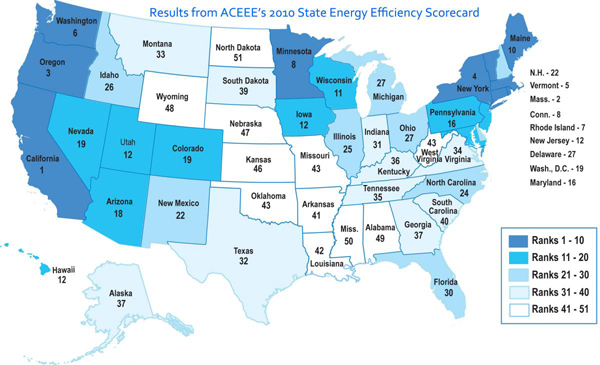T
erritories reward all manner of renewable energy use and green behavior. But the ultimate renewable, however unglamorous, may be the innovative technologies and policies that drive better energy efficiency.
One of the criteria used in evaluating states in Site Selection’s first annual Sustainability Rankings in July 2010 was their scores on the State Energy Efficiency Scorecard issued for the past three years by the non-profit and independent American Council for an Energy-Efficient Economy (ACEEE). In 2009 California topped the list — part of why it then topped Site Selection’s rankings this past July.
In October, ACEEE released its 2010 scorecard, and California topped the rankings again (as it’s done every year since the scorecard’s inception), followed closely by Massachusetts. The map to the right shows the rankings of all states.
Among the major state advances highlighted in the fourth edition of the ACEEE Scorecard are: a near doubling of state energy efficiency budgets from 2007 spending levels; the adoption or active consideration by over half the states of Energy Efficiency Resource Standards (EERS) that establish long-term, fixed efficiency savings targets; and a one-year doubling of the number of states that have either adopted or have made significant progress toward the adoption of the latest energy-saving building codes for homes and commercial properties.
“Even as Washington dawdles on climate and clean energy, states are moving ahead with considerable vigor on these vital matters, with energy efficiency initiatives leading the way,” said ACEEE Executive Director Steven Nadel. “In particular, states are moving forward and advancing energy efficiency policies and programs in an effort to create jobs and stimulate their economies during a period of considerable economic uncertainty. While $11 billion in American Recovery and Reinvestment Act funds was helpful in this process and there were setbacks in a few states, the overall story here is one of states getting done what Congress has so far failed to do.”
The four most-improved states — Utah (tied for #12, up 11 spots from 2009), Arizona (#18, up 11 spots), New Mexico (#22, up eight spots), and Alaska (#37, up eight spots) — climbed at least eight spots since the 2009 Scorecard. “In general,” said ACEEE, “the Southwest region demonstrated considerable progress from 2009 to 2010.”
“New Mexico has taken a number of steps under the leadership of Governor [Bill] Richardson to improve energy efficiency, including making sure new buildings are constructed to higher energy-saving standards and boosting utility energy-saving programs and services,” said New Mexico Department of Energy, Minerals, and Natural Resources Cabinet Secretary James Noel. “These steps will save consumers energy and money and create good local jobs that can’t be outsourced.”
Room for Improvement
The Scorecard examines six state energy efficiency policy areas and presents these results in six chapters (1) utility and public benefits programs and policies; (2) transportation policies; (3) building energy codes; (4) combined heat and power; (5) state government initiatives; and (6) appliance efficiency standards. States can earn up to 50 possible points in these six policy areas combined, with the maximum possible points in each area weighted by the magnitude of its potential energy savings impact.
Among other findings in the report:
- Texas (#32) and New Hampshire (#22) dropped the farthest in the 2010 Scorecard, down nine spots each. (In the inaugural rankings in 2007, Texas ranked #11.)
- State budgets for energy efficiency in 2009 are almost double the level of spending in 2007, increasing from $2.5 billion to $4.3 billion. Reported electricity savings from energy efficiency programs across all states increased 8 percent between 2007 and 2008 (the most recent available data).
- Twenty-seven states have adopted or have pending Energy Efficiency Resource Standards (EERS) that establish long-term, fixed efficiency savings targets — double the number of states in 2006. These states account for two-thirds of electricity sales in the U.S.
- Twenty states have either adopted or have made significant progress toward the adoption of the latest energy-saving building codes for homes and commercial properties — double the number of states in the 2009 scorecard.
- California, Massachusetts and Washington have implemented transportation-specific greenhouse gas reduction targets while several other states have adopted policies to encourage the creation of compact and transit-oriented communities.
- While steady progress on energy efficiency is evident across most of the country, several leading states, including Connecticut, New Jersey, New York, New Hampshire and the District of Columbia, have made plans to divert millions of dollars of energy efficiency funds to balance the budget or reduce deficits, “robbing their citizens of future energy savings and a more secure energy future,” said the ACEEE.
ACEEE is preparing to host its 30th annual conference in Washington, D.C., December 7-8, featuring keynote remarks from U.S. Dept. of Energy Secretary Steven Chu and Jon Wellinghoff, chairman of the Federal Energy Regulatory Commission.
The ACEEE report was issued nearly simultaneously with an announcement from the Clean Energy States Alliance (CESA) announcing the winners of the 2010 State Leadership in Clean Energy Awards. CESA is based in Vermont, a perennial top performer in the ACEEE rankings.
The programs and projects awarded this year are:
- California Energy Commission’s Public Interest Energy Research Program/Advanced Energy Recovery System
- California Energy Commission’s Renewable Energy Transmission Initiative
- Massachusetts Clean Energy Center’s Community Scale Wind Initiative
- New Jersey Board of Public Utilities Clean Energy Program’s Local Government Energy Audit
- Minnesota’s Xcel Energy Renewable Development Fund’s Renewable Energy Kit for Remote Telecom Equipment
- Energy Trust of Oregon’s Solarize Portland
- Sacramento Municipal Utility District’s Feed-In-Tariff Program.
“Today, the states are the major driving force in funding renewable energy projects throughout the U.S.,” said CESA Executive Director Mark Sinclair, echoing the ACEEE perspective. “States understand that clean energy has a key role in driving their environmental and economic progress.”
